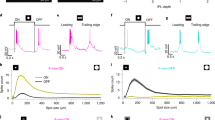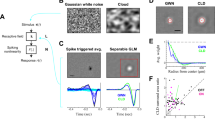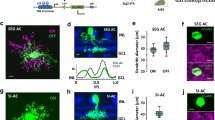Abstract
EXTRACELLULAR fields around active neural tissues are usually only a small fraction of the transmembrane voltages generating them, but this is not so in the arthropod compound eye. Light-evoked fields (the electroretinogram, ERG) can range over 10 mV amplitude1 and grow even larger near the receptor endings at the first synapse, the lamina (Fig. 1). The physical basis for such large fields is not understood although it has been suggested that there may be barriers of high resistance in the extracellular space2,3 across which current flow may generate large voltages. Direct measurements of extracellular resistance profiles in the insect eye reported here indicate that a barrier does exist. I also show the effect such a barrier must have on the retinal currents produced by light, which is to set up a system of electrical presynaptic inhibition on certain of the receptor terminals, acting through the extracellular space. When this neural circuit is defined in detail it can be shown that it specifically selects for inhibition only those neighbouring receptors with properties dissimilar to the excited elements. Such a system might be of general interest as a mechanism of inhibitory interaction, since it can act in a graded manner, needs no neural wiring to set it up, and no genetic programme to account for the selectivity its inhibition shows. The developmental problem of how a neurone can establish highly specific connections with follower cells4–6 and yet at the same time form a perhaps equally specific set of laterally-interacting connections with a quite different set of cells, is avoided with this particular mechanism.
This is a preview of subscription content, access via your institution
Access options
Subscribe to this journal
Receive 51 print issues and online access
$199.00 per year
only $3.90 per issue
Buy this article
- Purchase on Springer Link
- Instant access to full article PDF
Prices may be subject to local taxes which are calculated during checkout
Similar content being viewed by others
References
Hartline, H. K., Am. J. Physiol., 83, 466–483 (1928).
Burtt, E. T., and Catton, W. T., J. Insect Physiol., 10, 865–886 (1964).
Heisenberg, M., J. exp. Biol., 55, 85–100 (1971).
Braitenberg, V., Expl Brain Res., 3, 271–298 (1967).
Horridge, G. A., and Meinertzhagen, I. A., Proc. R. Soc., B 175, 69–82 (1970).
Macagno, E. R., Lopresti, V., and Levinthal, C., Proc. natn. Acad. Sci. U.S.A., 70, 57–61 (1973); ibid., 71, 1098–1102 (1974).
Hagins, W. A., Penn, R. D., and Yoshikami, S., Biophys. J., 10, 380–412 (1970).
Penn, R. D., and Hagins, W. A., Nature, 223, 201 (1969).
Ogden, T. E., and Ito, H., J. Neurophysiol., 34, 367–373 (1971).
Ioannides, A. C., and Walcott, B., Z. vergl. Physiol., 71, 315–325 (1971).
Shaw, S. R., J. Physiol., Lond., 220, 145–175 (1972).
Zettler, F., and Järvilehto, M., J. comp. Physiol., 85, 89–104 (1973).
Shaw, S. R., Symp. zool. Soc. Lond., 23, 135–163 (1968).
Horridge, G. A., Z. vergl. Physiol., 55, 207–224 (1967).
Rushton, W. A. H., Proc. R. Soc., B 162, 20–46 (1965).
Barlow, H. B., and Levick, W. R., J. Physiol., Lond., 200, 1–24 (1969).
Shaw, S. R., Vision Res., 9, 1031–1040 (1969).
Zettler, F., and Järvilehto, M., Z. vergl. Physiol., 76, 233–244 (1972).
Laughlin, S. B., J. comp. Physiol., 92, 357–375 (1974).
Furukawa, T., Furshpan, E. J., J. Neurophysiol., 26, 140–175 (1963).
Faber, D. S., and Korn, H., Science, 179, 577–8 (1973).
Author information
Authors and Affiliations
Rights and permissions
About this article
Cite this article
SHAW, S. Retinal resistance barriers and electrical lateral inhibition. Nature 255, 480–483 (1975). https://doi.org/10.1038/255480a0
Received:
Accepted:
Issue Date:
DOI: https://doi.org/10.1038/255480a0
This article is cited by
-
Invaginating Presynaptic Terminals in Neuromuscular Junctions, Photoreceptor Terminals, and Other Synapses of Animals
NeuroMolecular Medicine (2017)
-
Anatomical and physiological evidence for polarisation vision in the nocturnal bee Megalopta genalis
Journal of Comparative Physiology A (2007)
-
Fast and slow photoreceptors ? a comparative study of the functional diversity of coding and conductances in the Diptera
Journal of Comparative Physiology A (1993)
-
Behavioral experiments on the visual processing of color stimuli inPieris brassicae L. (Lepidoptera)
Journal of Comparative Physiology A (1987)
-
Neural superposition and oscillations in the eye of the blowfly
Journal of Comparative Physiology A (1987)
Comments
By submitting a comment you agree to abide by our Terms and Community Guidelines. If you find something abusive or that does not comply with our terms or guidelines please flag it as inappropriate.



